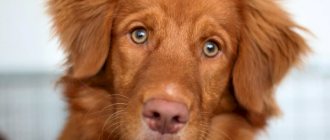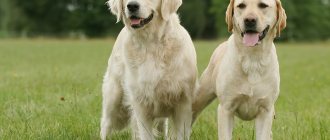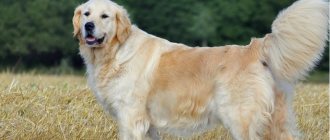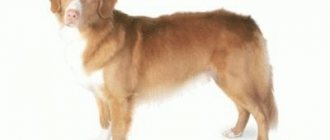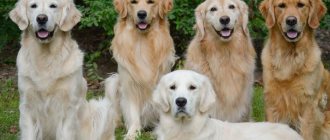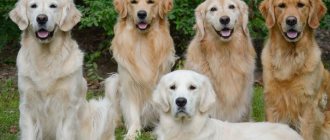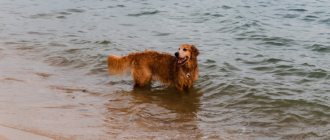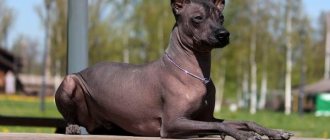History of the Golden Retriever breed
Golden Retriever
The main prerequisite for the emergence of the breed was the eternal passion of English aristocrats for hunting. In the 19th century, the main pastimes of British and Scottish Esquires were game baiting and duck shooting. The venerable peers disappeared for days in the forests and swamps, showing off to each other their trophies, guns and, of course, dogs. However, if the gentlemen had complete order with the hounds, then four-legged hunters, capable of finding a shot quail in the heather thickets or swimming after a duck that had fallen into the lake, were in great short supply. Commercial demand gave rise to supply, and soon shaggy dogs with an unusual golden coat color began to roam the valleys of Scotland.
The appearance of golden retrievers as an independent breed is usually associated with the name of Dudley Marjoribanks, a Scottish lord and part-time amateur breeder. It was he who showed the world a completely new type of hunting dog, which was not afraid of water and could skillfully retrieve a shot bird. For a long time, it remained a mystery whose blood flowed into the lord’s wards, until the secret records of his stud books were made public in the middle of the 20th century. As it turned out, the water tweed spaniel, Labrador, bloodhound and straight-haired retriever gave their genes to the goldens. At the same time, the first offspring was obtained as a result of mating a tweed water spaniel and a straight-haired retriever, which had a yellowish coat.
By the 20s of the last century, the breed was already quite popular not only in Europe, but also among breeders in the New World. In addition, the USA and Canada have formed their own standards of appearance for Golden Retrievers. For example, overseas people preferred individuals with more intense and dark coat color. The descendants of Scottish retrievers were brought to Russia after the collapse of the USSR, all from America. The first purebred dog entered the Russian Federation in 1991.
Breed characteristics and character
Inexperienced dog breeders often get confused when comparing a Labrador with a Golden Retriever . But these are completely different dogs, despite some similarities in appearance.
The adjective in the name of the breed has a direct connection with the coat color, and the noun can be interpreted as a combination of “hunting dog” or a designation of the verb “bring, save.” By the way, many breeds were previously called retrievers before their acquired name.
The Golden Retriever breed originated in Scotland, but cynologists call Britain its homeland. Among the animal's ancestors are setters, water spaniels, and Labradors. Pedigree breeding in Russia dates back to 1989. In relatively recent times, the golden retriever has gained the love of thousands of people, becoming a full member of the family.
And this is not surprising - the dog is calm and flexible, it is universal and is suitable for both a sports person and a retired homebody. The dog gets along well with children, even having the ability to nurse babies.
These animals are smart, capable of drawing independent conclusions, and understand intonation very well. If you take care of the dog and train it well, then by the age of one year he will already be able to master all the necessary skills. But this does not relieve the “golden” dog from full physical activity.
Appearance of a Golden Retriever
Golden Retriever Puppy
Golden Retrievers are moderately pumped up beauties with soulful eyes and luxurious iridescent fur. Goldens owe their recognition not so much to their own charm as to the efforts of marketers. American cinema promoted the breed especially actively. It is enough to watch a couple of comedy melodramas produced in the USA to understand: if an American family ever decides to get a dog, then in 9 cases out of 10 it will be a Golden Retriever.
The sexual type of representatives of this breed is clearly expressed. The height of the average boy ranges from 56-60 cm, and his weight can reach 41 kg. Girls are much lighter (average weight - 25-37 kg) and smaller than males (height - 51-56 cm).
Despite the presence of a single breed standard approved by the FCI, experts divide golden retrievers into three types:
- English;
- American;
- Canadian.
Representatives of the first group are natives of Foggy Albion, with extremely massive paws and a wide skull. They are distinguished by a lighter coat color, up to white. It is the English type that is most common in Europe and Russia. The complexion of the wards of American breeders is less impressive, but golden retrievers “made in the USA” can boast of graceful posture and a generally more elegant appearance. At the same time, the shade of their coat is slightly darker than that of their British counterparts. A distinctive feature of Canadian retrievers is their thin build and fairly tall stature. The coat color of the “Canadians” is even more rich and dark than that of the “Americans”.
English type golden retriever
American Golden Retriever type
Canadian type of golden retriever
Head
The skull is massive, convex-angular. The transition from forehead to muzzle is distinct and smooth. The occipital protuberance is smoothed, the cheeks are flat. The animal's muzzle is long, smooth, gradually tapering from the base to the nose.
Lips
Golden Retriever
Black, moderately dense and dry. The upper lip hangs noticeably over the lower lip, but does not extend beyond the jaw. The lips completely hide the dog's teeth and gums, forming small folds at the corners of the mouth.
Jaws and teeth
The retriever's jaws are strong and quite wide, with a pronounced scissor bite. The teeth are white and large. The incisors are located along the same line.
Nose
The lobe is massive, mobile, black. The nostrils are wide open.
Ears
Moderately long, hanging, hanging along the animal’s cheeks. The base of the ear is wide, the tip is narrow, smoothly rounded. Standing - slightly above the eye line.
Eyes
Large, deep-set, round in shape. The Golden Retriever has an intelligent, friendly look. The color of the iris ranges from brown to dark brown. The eyelids are black, dry, and fit tightly to the eyeball. An important condition: in a dog looking straight, the whites of the eyes should not be noticeable.
Satisfied muzzle of a golden retriever
Neck
Massive, high set and of moderate length. The neck muscles are strong, developed, there are no folds or sagging.
Frame
Retriever family
Adults have a strong, tightly built body with prominent muscles. The back of Golden Retrievers is straight, with a convex loin and pronounced withers. The croup is massive, slightly sloping, round in shape. The chest is of moderate width and quite deep. The tucked abdominal line ends in a short and well-shaped groin area.
Tail
Moderately long, with a wide, thickened base and a cone-shaped tip. Located below the back. A calm Golden's tail is lowered, while an excited Golden's tail is raised to the level of the back.
Limbs
The front legs are muscular, dry, and stand straight. The shoulders are strong, with massive shoulder blades and elbows laid back, pressed to the body. The humeroscapular angle does not exceed 90°. The pasterns are strong, but short, set at a slight angle.
The hind legs are strong, with well-developed muscles, and are spaced at a decent distance from each other. The hock joints of Golden Retrievers are low and point backward. The front and hind legs are of medium size and round in shape. The pads are massive, with short claws, the animal's fingers are folded into a ball.
Wool
The most important passenger
The coat of the Golden Retriever is characterized by increased rigidity and has a water-repellent function. The hair is quite thick and lies tightly to the body, hiding the abundant undercoat. The structure of the coat can be straight or lightly waved, and its length varies depending on the part of the body. The longest coat is located in the chest, ears, body, back of all four legs, and also in the lower part of the tail. Areas of the body with short hair are the head, paws and the front side of the limbs.
Color
All shades of gold are considered reference, up to the transition to cream color. Lighter colors are acceptable for feathering on the paws and tail feathering.
Possible defects
The list of breed defects includes any deviations from the characteristics prescribed by the standard. For example, it is undesirable for a Golden Retriever to have sparse and long hair, white stripes on the chest, and eyes that are too light and too close-set. The following defects may be grounds for not allowing an animal to compete:
- square body;
- long or too short legs;
- malocclusion and distorted lower jaw;
- cryptorchidism;
- lips, eyelids and nose, painted in any shade except black;
- a white “scarf” on the neck and marks on the forehead;
- black color of the coat, as well as the presence of spots on it;
- drooping tail.
Embittered or, conversely, cowardly individuals, animals with small heads, short ears and small teeth will also not make a serious career.
Breed standard
Weighing from 26 to 42 kg in males and from 25 to 37 kg in females. Golden Retrievers are between 56 and 61 cm tall for males and 51 to 56 cm for females. The Golden Retriever in the photo gives the impression of a symmetrical, harmonious, strong dog with balanced movements.
Golden retriever on a walk in spring
The head of an animal, more specifically, the expression of the eyes, is one of the most attractive parts of the body. And remembering that the retriever is considered a hunter, one should not be surprised at the strong, regular scissor bite. However, in Europe, the absence of some teeth is not considered a disadvantage.
A black nose is preferable. The dog looks at the world with wide-set dark brown eyes with a beautiful cut. The neck should be muscular and flow smoothly into the withers. And in general, the dog has a balanced body with a straight line of the spine.
The texture of the coat is either straight or slightly wavy. There is a dense undercoat. At the same time, some dog handlers agree that the fur coat should look natural, and traces of hairdressing scissors are not acceptable. All shades of cream and gold are acceptable, but in no case red. The color of the coat is rich.
Photo of a golden retriever
Personality of the Golden Retriever
Golden retriever plays with its owner
In terms of the number of enthusiastic reviews from owners, golden retrievers are almost ahead of all breeds. Indeed, only a convinced dog hater would be able to unearth the shortcomings in these good-natured intellectuals. As for ordinary animal lovers, their goldens literally captivate with their softness and phenomenal memory for faces. If one of your friends treated your pet to a tasty treat or entertained him with a simple game, you can be sure that the retriever will not forget to add a fat “plus” to this friend’s karma.
Calm and balanced in everyday life, representatives of this breed try to keep their cool even in the most delicate situations. They are completely non-confrontational and are ready to get along with any four-legged creature that does not show open aggression. Even in the most tense moments, goldens prefer to resolve matters peacefully. A golden retriever growling and clinging to an opponent with a death grip is something out of the realm of fantasy.
The breed is often recommended for keeping in families with children, since in relation to the younger generation the animals are as correct and patient as possible. Of course, entrusting a dog to babies is not the wisest decision, but it is quite possible to leave playful three-year-olds to it. Golden Retrievers are primarily people-oriented. It is with him that they want to go for walks, share their joys and sorrows. For this reason, goldens are often involved in active canistherapy. Shaggy “antidepressants” are happy to contact patients who are in a state of prolonged depression, charging them with bright emotions and gradually returning to them the joy of existence.
Golden retrievers are typical sanguine people, who are not at all characterized by such character traits as suspicion and caution. Strangers arouse curiosity and burning interest in these simple-minded fellows, so if there is a golden in your house, accept the fact that he will not be a guardian of the territory and material assets.
Golden Retriever with a child
This cat has found his place in life
Features of character and behavior
Golden Retrievers are sanguine dogs. They are friendly, active, lively and cheerful. In addition, these dogs have high intelligence and learning ability. Many breeders are confident that positive energy emanates from this breed. Indeed, retrievers have practically no disadvantages.
Goldens are perfect for any person with an active lifestyle. They are considered one of the best breeds for families with children; they can become a nanny for a baby and a life partner for a teenager.
Advantages
- Golden Retrievers are friendly towards everyone, even strangers and other pets. Despite their fairly strong, well-developed muscles, these dogs never come into conflict with other animals or people.
- They are devoted to their family, will always come to the rescue, and will serve faithfully until the end of their lives . They treat children wonderfully, love to play with them and tolerate all their antics. It is difficult to make a real nurse for a baby out of a Retriever.
- In many countries, Goldens are used as healing dogs to help children with disabilities learn about the world. They have a positive effect on patient rehabilitation. Representatives of the breed are also often trained to serve as guide dogs.
- Very smart. According to canine research, these dogs rank 4th in terms of intelligence development. They easily cope with learning commands, quickly understand the owner and remember everything they want to teach them. These dogs are also easy-going and helpful, and they really enjoy helping people.
- They have a quick reaction and can take responsibility for making decisions on their own. Often, retrievers saved people from fires and water without anyone's commands. Such pets are not inclined to manipulate the owner and take a leadership position in the house, even despite their developed intelligence.
- The instincts of the ancestors are still used for familiar purposes. Thanks to their sensitive hearing and keen sense of smell, Goldens can become good hunters with proper training.
Flaws
- Such dogs are completely unsuitable for protection. They are too friendly, never attack, and do not see people and animals as a threat. Although they can fight back, this is only in emergency cases.
- They can damage things due to excessive activity. If there is a lack of attention, the retriever will attract the owner with anything, be it a torn pillow or a dug up lawn.
- This breed needs training and comprehensive education. To get a loyal, devoted and obedient friend, you will have to try hard.
Education and training
Nature has not deprived golden retrievers of intelligence and memory, so the dog grasps any lessons on the fly. The first thing to start training a Golden Retriever puppy is obedience: the animal must understand what is allowed and what is not. Do not give in to the immediate desire to remove all restrictions and pamper your baby, so to speak, as an exception. The pranks of a puppy will quickly cease to seem touchingly funny after a 40-kilogram dog begins to practice them.
Golden Retriever training
In the first months of life, retriever babies try to taste the objects around them, so try to convey to your pet the meaning of the “Fu!” command as quickly as possible. Those who see a future hunter in a Golden Retriever will have to go outdoors more often. A dog can learn to find and bring back a shot bird only when it sees it in person. At first, the skill is practiced on rags and dummies: a homemade stuffed animal is thrown at the puppy to make him want to grab an unfamiliar thing and show it to his owner. Then they smoothly move on to fetching and participation in the hunt.
Six-month-old puppies can be taught swimming and obedience using a whistle, and it will be better if a professional does this. 12 months is the optimal age to start training a dog’s endurance, since when hunting she will often have to sit in ambush so as not to spook the game. The command “Lie down!” does not apply in such cases. It is enough that the pet sits next to you. Memory training exercises are considered very valuable, since a golden retriever is not always able to find game by smell alone.
Two curious faces
History of the origin of the species
Golden Retrievers were bred specifically for hunting. At that time, people needed a dog that would find and pick up shot game, but would not spoil it with its teeth. Retrievers, whose name translates as “lift and bring,” became precisely such helpers.
According to the official version, the breed was created in the 19th century by crossing Labradors, Bloodhounds, Setters and English Spaniels. The “father” of the Golden Retriever is considered to be the Scottish Lord Tweedmouth, who bought a light dog from a shoemaker and developed the breed through active selection. He made all the entries in his stud books from 1835 to 1889.
There is a legend that Lord Tweedmouth himself came up with; he told it to everyone who was interested in the breed. It was even published in the British magazine Country Life in the early 20th century.
The story goes that the first Golden Retrievers were bought by a lord at a circus. The young man became interested in the interesting appearance and incredible mental abilities of the dogs and bought eight of them for a huge amount of money. And this breed was called the Russian Shepherd.
This legend enjoyed some popularity among those few who owned the “mysterious” dog. But historian Elme Stoneks opened Tweedmouth's archival records and told the world about the real origin of the breed in the 40s and 50s of the 20th century.
The Lord gave and sold puppies only to close friends, so the breed was not known in Britain for a long time. Thanks to Lord Harcoat and Mrs. Charlesworth, retrievers appeared at exhibitions and even won the first breed awards.
The breed received official recognition from the English Kennel Club in 1913, and worldwide recognition only in the 60s of the 20th century. Now the Golden Retriever is one of the most popular dogs in the world.
Maintenance and care
Cream golden retriever puppy
Despite the fact that the main specialization of golden retrievers has always been hunting, it is completely unnecessary for today’s owners of these shaggy “servants” to take up a gun. Tiring runs through forests and swamps can be easily replaced with long walks through parks and meadows. It's great if you take your dog to a country house, away from the highway, where he can run around to his heart's content. Just don’t try to turn your pet into a mongrel and put him in a kennel: the retriever will not appreciate your impulse and will become despondent - so take the dog into the house and do not deprive him of his own company.
Keeping a Golden Retriever in an apartment is a kind of test of the owner’s responsibility and hard work, since the animal will have to compensate for the lack of free space, physical activity and impressions with regular promenades combined with physical activity. Due to their sociable nature, Golden Retrievers do not cope well with being alone. Animals express their uncertainty and fear on surrounding objects: they chew furniture and wires, and damage shoes. The worst punishment an owner can come up with for a golden dog is to lock it up within four walls and quietly go to work. For careerists, workaholics, travelers and other busy individuals, a golden retriever as a pet is not an acceptable option.
What not to do with a Golden Retriever:
- allow children to sit on an older dog, since the pressure created by the child’s body can cause the animal’s back to bend;
- pet the puppy on the head and put a collar over its head, which leads to incorrect ear set;
- pull the baby by the paws or try to lift him, fixing his hand under the chest.
Hygiene
The main problem for the owner of a golden retriever is the fur of his pet. During the molting period, the golden leaves furry marks wherever possible, and daily scratching helps little. There are only two ways out of this situation: not to buy a golden retriever at all, or to come to terms with this peculiarity of the dog and purchase a powerful vacuum cleaner to clean up the scraps behind it from time to time.
And some water for me!
Brush your shedding retriever twice a day using a brush and a mitt to collect hair. Dense undercoat is removed with a furminator or slicker. To remove dog smell from fur, you can moisten it with a solution prepared according to the following recipe:
- mix a glass of water with a glass of vodka;
- add 2 tablespoons of vinegar essence;
- add 1 teaspoon of salt and shake.
During the periods between moults, the animal’s fur does not require such careful care, but you will still have to go through the dog’s “fur coat” with a comb a couple of times a week. Goldens are given a bath once a month and that is quite enough. After bathing, you can slightly shorten your pet's fur. The hair is cut from bottom to top, starting from the neck. It is not forbidden to use scissors to go through the fur on the dog’s paws and “pants.” The hair growing between the toes and at the base of the tail should also be trimmed regularly.
Most Golden Retrievers have unproblematic eyes and ears, so a standard weekly checkup is sufficient. If dirt has accumulated in the ear specula, you can remove it with a napkin and boiled water. Chilled tea leaves are suitable for treating the eyes. Cleaning your Golden's teeth is a labor-intensive process, but necessary. If you can’t clean your mouth using the classic method, you can entrust this task to dry food or special treats, whose solid particles act as abrasives that “erase” plaque.
Feeding
It's someone's birthday today
Golden Retrievers can be fed both natural foods and dry food. In the first case, about 50% of the diet should come from animal protein, that is, meat. The daily norm of the product is calculated as follows: 10-20 grams of meat per kilogram of dog weight. The remaining half of the retriever’s daily “menu” consists of cereals and vegetables.
Meat for dogs is selected to be lean, with a lot of veins and cartilage. Beef, lamb, rabbit and turkey are ideal. By-products are also not prohibited, but due to the digestive upset that they can provoke, they are introduced into the diet gradually and little by little.
Important: Golden Retrievers are fed after a walk, not before it.
It is better to cook thick porridges from rice and buckwheat, to which you can add stewed vegetables. Pumpkin, carrots, cabbage, turnips and beets are especially beneficial for golden retrievers. During the season, early greens are mixed into the porridge. It is not forbidden to include fermented milk products - kefir, yogurt, cottage cheese - in the diet of an adult dog. Puppies, whose skeleton is still developing, require more calcium, so for up to 4 months, the diet of small goldens must include milk (whole and as part of porridge).
Approximate daily menu for a 4-month-old baby: 300 g of meat, 100 g of sliced fruits and vegetables or vegetable stew (apple + carrot), 500 g of porridge with milk.
Trick or treat
Golden retriever on the beach
How many times to feed
Until 4 months, golden retriever puppies receive food 5 times a day. Starting from 5 months, babies are transferred to four meals a day. Six-month-old adolescents eat three times a day, and by 8 months the puppies completely switch to twice feeding.
Walk
Walk golden retrievers at least two hours a day. However, it is not at all necessary to maintain the same duration of walks. For example, the morning promenade can be reduced to 30 minutes, and the evening promenade, on the contrary, can be increased to one and a half hours. If the animal lives in an apartment, then until four months it should not be allowed to go up and down stairs on its own. Take the puppy for a walk in your arms and bring him into the apartment in the same way.
Babies are taken outside more often than adults to develop the skill of using the outdoor toilet. First, excursions are conducted through park areas, gradually moving to busy city streets. It is very important that the dog does not fall into a stupor at the sight of people and the sounds of public transport, so the more often it encounters everyday phenomena in the urban environment, the faster it will learn to perceive them adequately.
Privacy with the owner
Golden Retrievers and Water
Golden retriever playing in a mountain river
Golden retrievers love water treatments, so during a walk the puppy will certainly try to measure the depth of the first puddle it comes across. Accordingly, if you notice a pothole filled with water on the way, it is better to prevent the animal from rushing by taking it by the collar and strengthening the prohibition with the command “No!” If the moment is missed, and the pet is already swimming in a puddle with all his might, shout at him (the same command “Ugh!” will do) and throw a leash at him. You should not go into the water and try to pull the dog out. Wait for her to obey the command and praise her for her obedience. But you shouldn’t give up swimming in open waters. Swimming in a pond, river or lake for a dog is gymnastics and psychotherapy in one bottle, so when going for a weekend in nature, feel free to take your golden dog with you.
Health and Diseases of Golden Retrievers
Retrievers resting after a walk
For veterinary clinics, goldens are one of the most profitable pets, and their owners are one of the most frequent visitors. The main diseases of the Golden Retriever, mentioned in almost every reference book, are retinal degeneration and hip dysplasia. However, in fact, the breed is also associated with about a dozen different ailments. For example, dogs are often diagnosed with cancer and heart diseases, hypothyroidism, atopic dermatitis, von Willebrand disease and other dangerous ailments.
In addition, Golden Retrievers are prone to obesity. Compared to more serious illnesses, excessive weight seems like a harmless trifle, although in reality everything is not so rosy. Animals that have put on extra pounds live shorter lives, and those with excess body weight suffer more from the constant companion of all older dogs - arthritis. An animal’s diseased teeth also pose a serious danger. An ordinary abscess on the gum or an inflamed tooth can “spread” the infection throughout all the organs of the retriever, ultimately sending him to doggy heaven.
External features
The Golden Retriever has a strong build, a medium-sized body, and is well developed. The limbs are quite strong with large paws.
Light-colored wool (cream, beige) with slight waviness. The thick, impenetrable undercoat allows the dog to hunt in water. The tail is long, straight, and raised when active.
Thanks to its quick reaction and increased activity, this dog is suitable for searching for explosive and narcotic substances.
Photos of a golden retriever show his majestic appearance, his nobility.
How to choose a puppy
- When going to the nursery, arm yourself with a printout of the breed standard, or better yet, take with you a specialist who will help you choose a puppy. If this is not possible, contact any of the kennel clubs, where they will recommend you a reliable breeder.
- Puppies inherit from their parents not only their appearance and hunting qualities, but also their temperament type, so when talking with the seller, insist on getting to know the mother and father of the babies. If such a favor is refused to the buyer, there is a high probability that the pedigree of the dogs is so-so.
- For those who see a future family friend in a golden retriever, it is better to purchase bitches that are more docile and affectionate. Golden males are distinguished by their bright charisma, but their character is more serious and firm. In addition, boys are much smarter when it comes to hunting.
- The temperaments of American and European retrievers differ significantly - take this fact into account when buying a puppy. Goldens from the USA are more energetic and emotional. Native “Europeans” are noticeably more phlegmatic and do not suffer from hyperactivity.
- Responsible breeders who value their own name have puppies that are well-groomed, vaccinated and treated with anthelmintics.
Photos of golden retriever puppies
How much does a golden retriever cost?
Pet-class puppies remain the most attractive option in terms of price: from 20,000 to 25,000 rubles. Almost invisible defects in appearance significantly reduce the cost of a golden retriever, which will especially appeal to those who do not dream of exhibitions and championship titles and are not averse to saving money. Prices for show class start from 35,000 rubles. and end around 50,000 rubles. An option designed for the most generous buyers is offspring obtained from interbreeding, with the right to further breeding. The cost of such a puppy is 70,000 - 80,000 rubles.
Breed characteristics
| Short description | |
| Origin: | Great Britain |
| Conditions of detention: | House with adjacent territory, apartment (with regular long walks) |
| Purpose: | Companion dog, nanny dog, hunter dog |
| Color: | From golden to creamy |
| Wool length: | Long |
| Adult dog size: | The height of females is 51-56 cm, males 56-61 cm, weight of males is approximately 26-42 kg, females - 25-37 kg |
| Average life expectancy: | 8-10 years |
| Walk: | Required 2 times a day |
| Physical activity needs: | High physical activity needs (regular or daily exercise for more than 3 hours per day) |
| Fédération Cynologique Internationale (FIC) classification: | Group 8: Retrievers, Spaniels and Water Dogs; Section 1: Retrievers |
| Puppy price: | From 15 to 30 thousand rubles. Without pedigree up to 15 thousand rubles. Pet class: 15-20 thousand rubles. Breeding class: from 20 thousand rubles. Show class: from 30 thousand rubles. |


